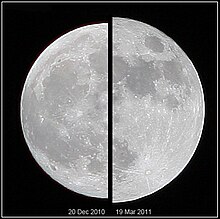supermoon
Appearance
English
[edit]
Alternative forms
[edit]Etymology
[edit]From super- + moon. Coined by astrologer Richard Nolle in 1979.[1]
Pronunciation
[edit]Noun
[edit]supermoon (plural supermoons)
- (astrology, astronomy) A full moon or new moon, when the Earth–Moon distance is in the lowest tenth of its range.
- Synonym: perigee moon
- Antonym: micromoon
- Coordinate terms: full moon, new moon
- 2014 September 7, Natalie Angier, “The Moon comes around again [print version: Revisiting a moon that still has secrets to reveal: Supermoon revives interest in its violent origins and hidden face, International New York Times, 10 September 2014, p. 8]”, in The New York Times[1]:
- And should the moon happen to hit its ever-shifting orbital perigee at the same time that it lies athwart from the sun, we are treated to a so-called supermoon, a full moon that can seem close enough to embrace – as much as 12 percent bigger and 30 percent brighter than the average full moon. […] Some astronomers dislike the whole supermoon hoopla. They point out that the term originated with astrology, not astronomy; that perigee full moons are not all that rare, coming an average of every 13 months; and that their apparently swollen dimensions are often as much a matter of optical illusion and wishful blinking as of relative lunar nearness.
Usage notes
[edit](perigee moon): Some claim this is not a syzygy unless a solar eclipse or lunar eclipse also occurs, but most references disagree.
Translations
[edit]a full moon or new moon, when the Earth–Moon distance is in the lowest tenth of its range
|
See also
[edit]References
[edit]- ^ Richard Nolle (2011 March 14 (last accessed)) “Supermoon”, in Astropro:
- SuperMoon is a word I coined in a 1979 article for Dell Publishing Company's HOROSCOPE magazine, describing a new or full moon which occurs with the Moon at or near (within 90% of) its closest approach to Earth in a given orbit (perigee). In short, Earth, Moon and Sun are all in a line, with Moon in its nearest approach to Earth.


